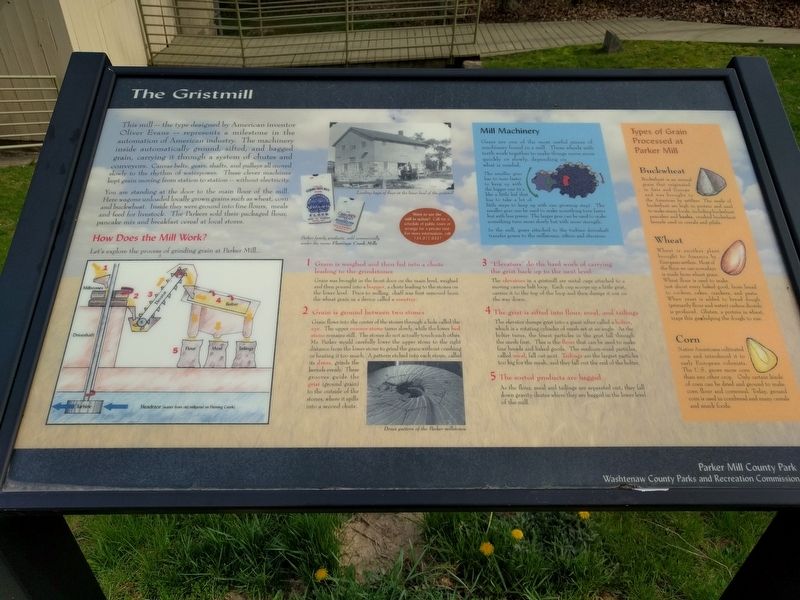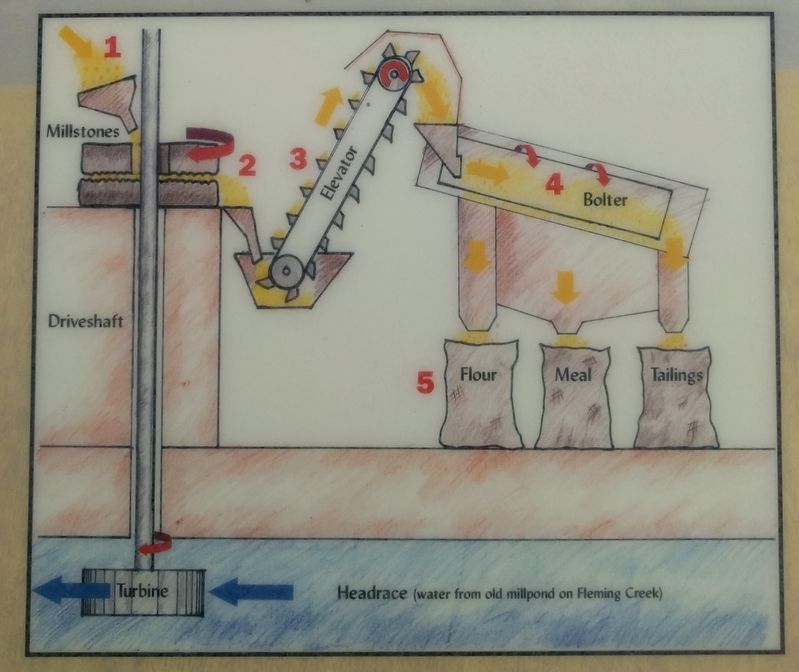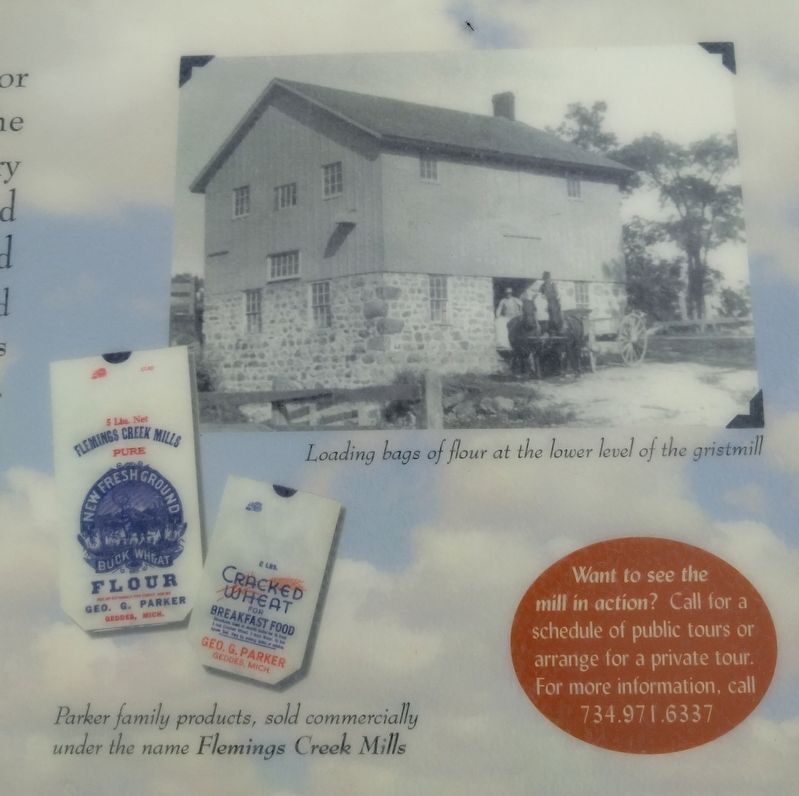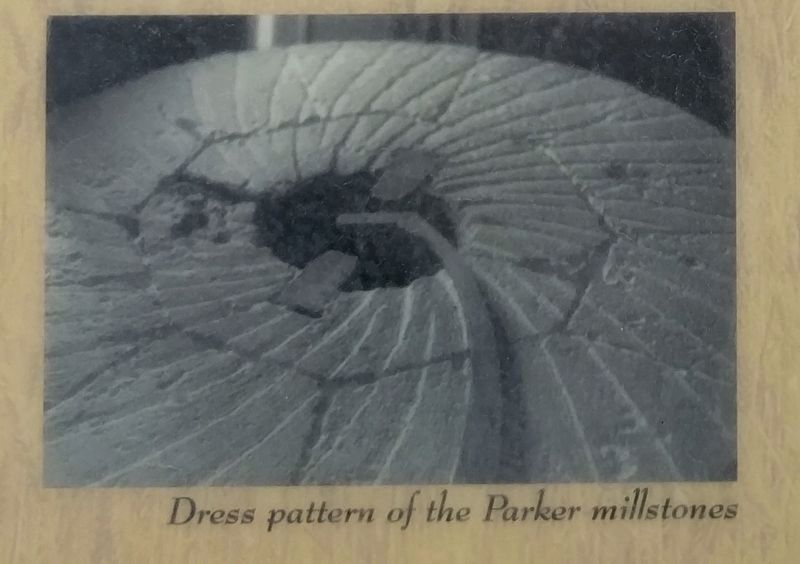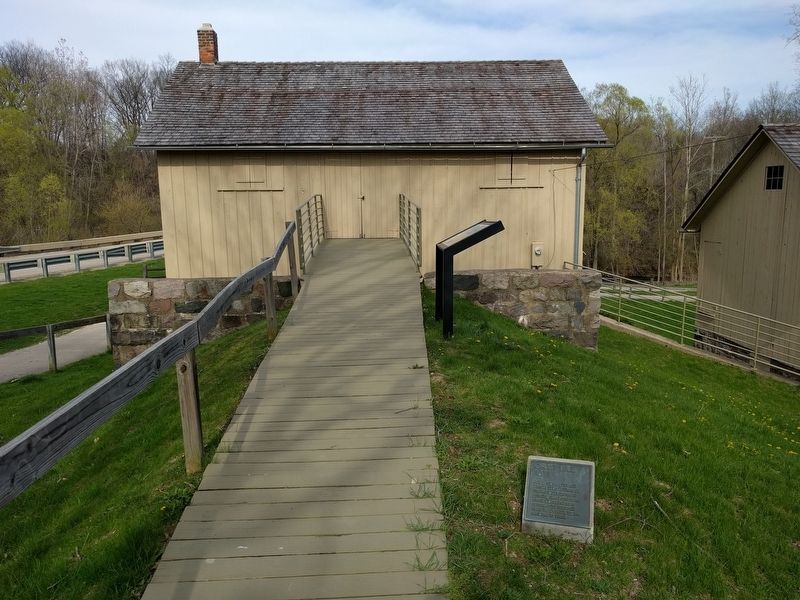King near Ann Arbor in Washtenaw County, Michigan — The American Midwest (Great Lakes)
The Gristmill
This mill -- the type designed by American inventor Oliver Evans -- represents a milestone in the automation of American industry. The machinery inside automatically ground, sifted, and bagged grain, carrying it through a system of chutes and conveyors. Canvas belts, gears, shafts, and pulleys all moved slowly to the rhythm of waterpower. These clever machines kept grain moving from station to station -- without electricity.
You are standing at the door to the main floor of the mill. Here wagons unloaded locally grown grains such as wheat, corn and buckwheat. Inside they were ground into fine flours, meals and feed for livestock. The Parkers sold their packaged flour, pancake mix and breakfast cereal at local stores.
How Does the Mill Work?
Let's explore the process of grinding grain at Parker Mill...
1 Grain is weighed and then fed into a chute leading to the grindstones
Grain was brought in the front door on the main level, weighed and then poured into a hopper, a chute leading to the stones on the lower level. Prior to milling, chaff was first removed from the wheat grain in a device called a smutter.
2 Grain is ground between two stones.
Grain flows into the center of the stones through a hole called the eye. The upper runner stone turns slowly, while the lower bed stone remains still. The stones do not actually touch each other. Mr. Parker would carefully lower the upper stone to the right distance from the lower stone to grind the grain without crushing or heating it too much. A pattern etched into each stone, called its dress, grinds the kernels evenly. These grooves guide the grist (ground grain) to the outside of the stones where it spills into a second chute.
3 "Elevators" do the hard work of carrying the grist back up to the next level
The elevators in a gristmill are metal cups attached to a moving canvas belt loop. Each cup scoops up a little grist, carries it to the top of the loop and then dumps it out on the way down.
4 The grist is sifted into flour, meal, and tailings
The elevator dumps grist into a giant sifter called a bolter, which is a rotating cylinder of mesh set at an angle. As the bolter turns, the finest particles in the grist fall through the mesh first. This is the flour that can be used to make fine breads and baked goods. The medium-sized particles, called meal, fall out next. Tailings are the largest particles too big for the mesh, and they fall out the end of the bolter.
5 The sorted products are bagged
As the flour, meal and tailings are separated out, they fall down gravity chutes where they are bagged in the lower level of the mill.
Mill Machinery
Gears are one of the most useful pieces of machinery found in a mill. These wheels with teeth work together to make things move more quickly or slowly, depending on what is needed.
The smaller gear has to turn faster to keep up with the bigger one (it's like a little kid that has to take a lot of little steps to keep up with one grownup step). The smaller gear can be used to make something turn faster but with lesser power. The larger gear can be used to make something turn more slowly but with more strength.
In the mill, gears attached to the turbine driveshaft transfer power to the millstones, sifters, and elevators.
Types of Grain Processed at Parker Mill
Buckwheat
Buckwheat is an annual grain that originated in Asia and Europe and was brought to the Americas by settlers. The seeds of buckwheat are high in protein and used to make many foods, including buckwheat pancakes and kasha, crushed buckwheat kernels used in cereals and pilafs.
Wheat Wheat is another plant brought to America by European settlers. Most of the flour we use nowadays is made from wheat grain. Wheat flour is used to make just about every baked good, from bread to cookies, cakes, crackers, and pasta. When yeast
is added to bread dough (primarily flour and water) carbon dioxide is produced. Gluten, a protein in wheat, traps this gas helping the dough to rise.
Corn
Native Americans cultivated corn and introduced it to early European colonists. The U.S. grows more corn than any other crop. Only certain kinds of corn can be dried and ground to make corn flour and cornmeal. Today, ground corn is used in cornbread and many cereals and snack foods.
Erected by Parker Mill County Park, Washtenaw County Park and Recreation Commission.
Topics. This historical marker is listed in this topic list: Industry & Commerce.
Location. 42° 16.442′ N, 83° 40.068′ W. Marker is near Ann Arbor, Michigan, in Washtenaw County. It is in King. Marker is on Geddes Road, 0.2 miles east of North Dixboro Road, on the right when traveling east. Marker is in Parker Mill County Park, near the parking lot. Touch for map. Marker is at or near this postal address: 4650 Geddes Road, Ann Arbor MI 48105, United States of America. Touch for directions.
Other nearby markers. At least 8 other markers are within walking distance of this marker. Grist Mill (a few steps from this marker); Cider Mill (a few steps from this marker); Welcome to the Parker Family Mills! (a few steps from this marker); Native American Trails (a few steps from this
marker); The Power of Fleming Creek (within shouting distance of this marker); The Parker Family & Mill (within shouting distance of this marker); Hoyt Garrod Post and Family History (within shouting distance of this marker); Landscape Transformed (within shouting distance of this marker). Touch for a list and map of all markers in Ann Arbor.
Credits. This page was last revised on February 12, 2023. It was originally submitted on June 26, 2017, by Joel Seewald of Madison Heights, Michigan. This page has been viewed 712 times since then and 45 times this year. Photos: 1, 2, 3, 4, 5. submitted on June 26, 2017, by Joel Seewald of Madison Heights, Michigan.
